Summary: If you are still hesitate to buy an interchangeable lens camera or not, you are come to the right place, this article will be brief introduce you the the interchangeable lens camera and give the the solution on editing the video you recorded by an interchangeable lens camera in FCP, Premiere or Avid. What is an interchangeable lens camera?Literally just any digital camera where the lens can be (inter)changed. So we're not counting screw-on lens adapters here, we mean proper dedicated lenses. There are two types of ILC - Digital Single Lens Reflex (DSLRs) and mirrorless. Why buy an interchangeable lens camera?So you've decided to invest in a new digital camera and have made your mind up that you want to step up to a interchangeable lens model, but the huge range of camera on offer and endless flow of technical jargon have left you more confused than when you started? Fear not, this page will take the pain out of choosing the perfect camera for you, whether you're a seasoned shooter or a total novice.Before we get down to business it's worth stopping for a moment to ask the question: why would anyone want an interchangeable lens camera (ILC) when fixed-lens compacts are so much smaller, lighter and more affordable? The answer can be summed up in two words: versatility and image-quality.The versatility isn't just the fact you can change lenses and add a wide range of accessories - from basics such as flashguns and remote controls to the more specialized equipment that allow ILCs to capture anything from the tiniest bug to the most distant stars. It's also about the creative versatility offered by the more advanced controls and higher quality components.And this leads on to the second factor; image quality. In broad daylight the quality difference between a good compact and a ILC is minimal; both will produce sharp, colorful results with little effort. But when you start to push the boundaries a bit more; shooting in low light, attempting to capture fast moving sports action or wildlife, or when you want to experiment with shallow depth of field (to add a soft background to a portrait for example), the advantage of a ILC's larger sensor and higher sensitivity start to make a big difference. An ILC can't beat a compact camera for 'pop it in the purse or pocket' convenience but for serious photography the ILC wins hands down. With prices lower than ever it's not that surprising to discover that many people own one of each.Mirrorless ILC advantagesSmaller, lighter and usually quieter than equivalent SLRGenerally smaller and lighter lensesSuperior video operation and usually better video specification, tooEase of use with many compact camera features (such as face detection and wide AF areas)Electronic viewfinders often larger with greater coverage than entry-level SLR optical viewfindersFull shooting information and menus in the (electronic) viewfinderMirrorless ILC disadvantagesSome mirrorless ILCs only offer contrast-detection AFEven those mirrorless ILCs with hybrid phase-detection AF often can't quite keep up with equivalent DSLRs for subject trackingMany electronic viewfinders still cannot match the clarity of a good optical finder (and some people just prefer optical)Edit ILC video more smoothlyThere are very many apps in the market to consider using for video editing, such as Adobe Premiere, Final Cut Pro, Avid. They have their specific features, pros and cons as well as pricing that inform decision of any user. If you are not well informed on that, it might end up causing you confusion. Adobe Premiere is a software program for editing video and uses timeline to accomplish that. Its presence in the market has surely revolutionized the video editing industry thanks to its standout features. Its presence in the market has surely revolutionized the video editing industry thanks to its standout features. You can edit your videos smoothly with Final Cut Pro program and can handle more than one stream with maximum resolution. Its playback is very powerful and that adds to the easy editing experience. You will like the user-friendly interface because it comes with four windows for editing. AVID is the best software to help you connect with other people in a very efficient, powerful and collaborative manner. It has very many features to allow you customize your video during editing and you must get maximum value in return for that.No matter what kind of editor you are chosen for your editing job, you may encounter such many problems like no audios, no video images or can’t be imported issues. The thing you should make clear is that every editor has it’s best compatible format or codec, for Adobe Premiere, the best compatible format or codec is MPEG-2, for Final Cut Pro, the best compatible format or codec is Apple ProRes(Apple ProRes Codec Types), for Avid, the best compatible format or codec is Avid DNxHD(*.mov). There if you make the video you recorded into the best compatible format or codec for the editor you have chosen, the edit job will be easier or more smoothly. Pavtube Video Converter / Mac Version are high recommend here for you. It is a professional video tool can be convert all the camera video into the editor best compatible format or codec.
Why buy an interchangeable lens camera?So you've decided to invest in a new digital camera and have made your mind up that you want to step up to a interchangeable lens model, but the huge range of camera on offer and endless flow of technical jargon have left you more confused than when you started? Fear not, this page will take the pain out of choosing the perfect camera for you, whether you're a seasoned shooter or a total novice.Before we get down to business it's worth stopping for a moment to ask the question: why would anyone want an interchangeable lens camera (ILC) when fixed-lens compacts are so much smaller, lighter and more affordable? The answer can be summed up in two words: versatility and image-quality.The versatility isn't just the fact you can change lenses and add a wide range of accessories - from basics such as flashguns and remote controls to the more specialized equipment that allow ILCs to capture anything from the tiniest bug to the most distant stars. It's also about the creative versatility offered by the more advanced controls and higher quality components.And this leads on to the second factor; image quality. In broad daylight the quality difference between a good compact and a ILC is minimal; both will produce sharp, colorful results with little effort. But when you start to push the boundaries a bit more; shooting in low light, attempting to capture fast moving sports action or wildlife, or when you want to experiment with shallow depth of field (to add a soft background to a portrait for example), the advantage of a ILC's larger sensor and higher sensitivity start to make a big difference. An ILC can't beat a compact camera for 'pop it in the purse or pocket' convenience but for serious photography the ILC wins hands down. With prices lower than ever it's not that surprising to discover that many people own one of each.Mirrorless ILC advantagesSmaller, lighter and usually quieter than equivalent SLRGenerally smaller and lighter lensesSuperior video operation and usually better video specification, tooEase of use with many compact camera features (such as face detection and wide AF areas)Electronic viewfinders often larger with greater coverage than entry-level SLR optical viewfindersFull shooting information and menus in the (electronic) viewfinderMirrorless ILC disadvantagesSome mirrorless ILCs only offer contrast-detection AFEven those mirrorless ILCs with hybrid phase-detection AF often can't quite keep up with equivalent DSLRs for subject trackingMany electronic viewfinders still cannot match the clarity of a good optical finder (and some people just prefer optical)Edit ILC video more smoothlyThere are very many apps in the market to consider using for video editing, such as Adobe Premiere, Final Cut Pro, Avid. They have their specific features, pros and cons as well as pricing that inform decision of any user. If you are not well informed on that, it might end up causing you confusion. Adobe Premiere is a software program for editing video and uses timeline to accomplish that. Its presence in the market has surely revolutionized the video editing industry thanks to its standout features. Its presence in the market has surely revolutionized the video editing industry thanks to its standout features. You can edit your videos smoothly with Final Cut Pro program and can handle more than one stream with maximum resolution. Its playback is very powerful and that adds to the easy editing experience. You will like the user-friendly interface because it comes with four windows for editing. AVID is the best software to help you connect with other people in a very efficient, powerful and collaborative manner. It has very many features to allow you customize your video during editing and you must get maximum value in return for that.No matter what kind of editor you are chosen for your editing job, you may encounter such many problems like no audios, no video images or can’t be imported issues. The thing you should make clear is that every editor has it’s best compatible format or codec, for Adobe Premiere, the best compatible format or codec is MPEG-2, for Final Cut Pro, the best compatible format or codec is Apple ProRes(Apple ProRes Codec Types), for Avid, the best compatible format or codec is Avid DNxHD(*.mov). There if you make the video you recorded into the best compatible format or codec for the editor you have chosen, the edit job will be easier or more smoothly. Pavtube Video Converter / Mac Version are high recommend here for you. It is a professional video tool can be convert all the camera video into the editor best compatible format or codec.
 Key Features of Pavtube Video Converter.
Key Features of Pavtube Video Converter.
- Convert almost all HD/SD audio/video formats: All types of audios and videos (e.g. SD/HD/Tivo/DRV/Camcorder HD footages, etc) to almost any audio and video formats.
- hange default settings: You can change the parameters such as video size, bitrate, frame rate, and channels for your video file according to your need to get the best output effect.
- Batch conversion: Handle multiple videos and realize batch conversion to save your time and energy.
- Merging & splitting: Merge several video clips into one bigger file and splitting one video file into several clips according to the clip quantity, duration time and file size.
- Create new output format: Adjust profile parameters, rename and save it for future use.
- Supported OS: Windows XP/2003/Vista/Windows 7/Windows 8/Windows 8.1/Windows 10
- Supported OS: Mac OS X 10.11 El Capitan, Mac OS X 10.10 Yosemite, 10.9 Mavericks, 10.8 Mountain Lion, 10.7 Lion, 10.6 Snow Leopard, 10.5 Leopard
How to Make Eidting Work More Smoothly?
First free download and install Pavtube Video Converter on your Mac or Windows, and then launch it. Now just follow the step by step guide to make editing work more smoothly.Step 1: Install and launch this program. Just drag and drop video files to the main interface of the program to add videos. If you have several video files that you want to convert in batch, just drag the folder where the sources are to the software. 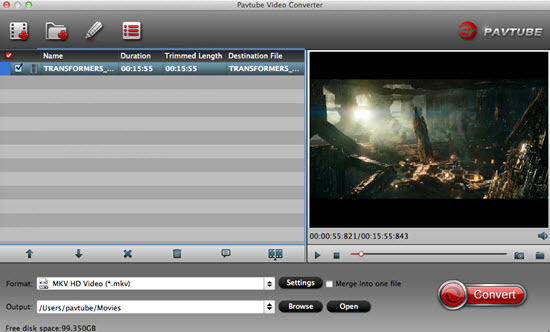 Step 2: Click the “Format” drop-down menu to choose an output format that you prefer.From "Format" drop-down lists, you can select Avid Media Composer preferable editing codec from "Avid Media Composer" > "Avid DNxHD(*.mov)" as the output format.
Step 2: Click the “Format” drop-down menu to choose an output format that you prefer.From "Format" drop-down lists, you can select Avid Media Composer preferable editing codec from "Avid Media Composer" > "Avid DNxHD(*.mov)" as the output format.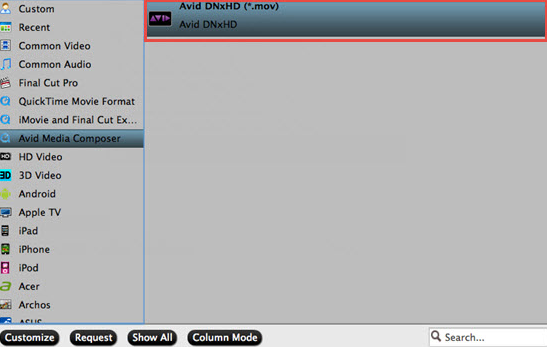 Click "Format" bar, from its drop-down options, move your mouse to "Final Cut Pro > Apple ProRes 422 (*.mov)" to select it as the output file format.
Click "Format" bar, from its drop-down options, move your mouse to "Final Cut Pro > Apple ProRes 422 (*.mov)" to select it as the output file format.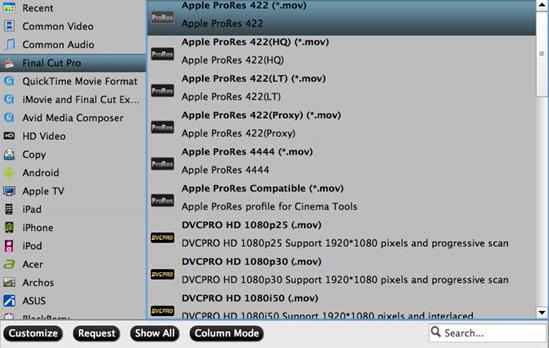 From the "Format" drop-down list, go to select "Adobe Premiere Pro/Sony V..." >"MPEG-2" as the most suitable output format for Adobe Premiere Pro.
From the "Format" drop-down list, go to select "Adobe Premiere Pro/Sony V..." >"MPEG-2" as the most suitable output format for Adobe Premiere Pro.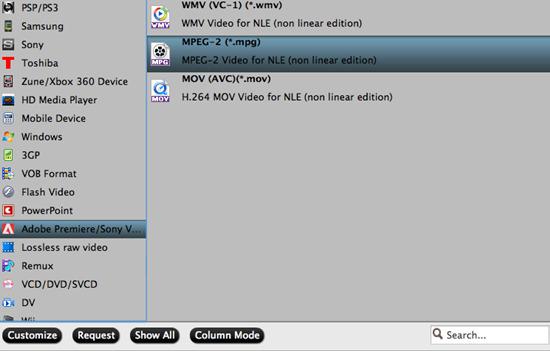 Step 3: Before converting, you can edit the Canon footage to achieve a better overall effect. Simply highlight a video clip and click the “Edit” button beside it to enter the Video Edit window. You can then crop, trim, rotate videos, adjust Canon recordings effects, add text/image watermarks, etc. as you like. Or you can open "Profile Settings" window to adjust the output video codec, size, bit rate, frame rate, audio codec, sample rate, bit rate and channels. Here i just give a Apple ProRes as the example, others for Avid and Premiere are nearly the same.
Step 3: Before converting, you can edit the Canon footage to achieve a better overall effect. Simply highlight a video clip and click the “Edit” button beside it to enter the Video Edit window. You can then crop, trim, rotate videos, adjust Canon recordings effects, add text/image watermarks, etc. as you like. Or you can open "Profile Settings" window to adjust the output video codec, size, bit rate, frame rate, audio codec, sample rate, bit rate and channels. Here i just give a Apple ProRes as the example, others for Avid and Premiere are nearly the same.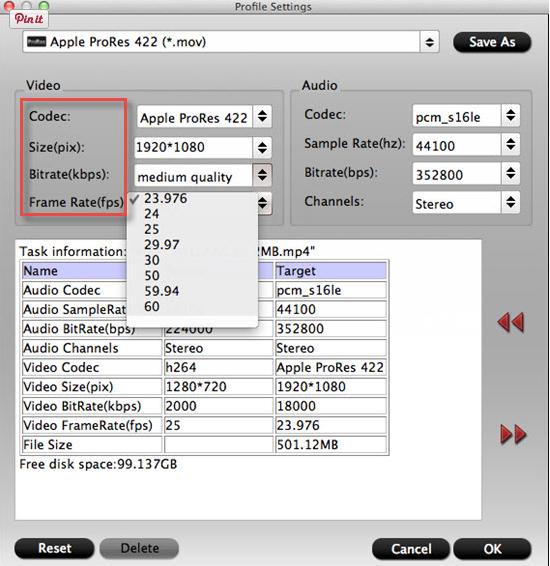 Step 4: Hit the convert button under the preview windows, the conversion will started immediately. When the conversion is completed, run the editor and import the converted footage with more smoothly editing.Read More:
Step 4: Hit the convert button under the preview windows, the conversion will started immediately. When the conversion is completed, run the editor and import the converted footage with more smoothly editing.Read More:
Summary: When you open an FLV file the player may give you a warning message saying that it doesn't recognize the file extension. This article will help you get out of that issue.As soon as one tries to play a FLV file with the help of Windows Media Player, a message will appear saying that the file can't be opened because the extension is invalid. Properly configured codecs needs to be installed to play FLV files using Windows Media Player. The formats supported by windows are .asf, .wmx, .au, .snd, .mov, .m4a, .dvr-ms, .asx, .m4v, .mp4, .wpl, .mpg, .miv, .mpa, .mp2, .mpeg, .3g2, .adts, .adt, .3gp2, .aiff, .wms, .3gp, .mp3, .m3u, .mid, .midi, .mpv2, .cda, .rmi, .wav, .wax, .aif, .wmv, .ivf, .3gpp, .wm, .mpc, .aifi, .aac, .wvx, .wma, .wm2, .m2ts, .mp4v, .avi and .wmd. Play FLV after Installing FLV codecs for Windows Media PlayerWMP uses codecs to play media files. Codecs of many formats are inbuilt in WMP to open files of that format. Yet the codec of FLV needs to be downloaded by the user to run FLV files on WMP. After successfully installing the codec, you will be able to run files with .flv extension in your WMP.If one is unable to view their files on Window Media Player because the file has .flv extension, then Pavtube Video Converter can be used to convert the videos in the format supported by the Window Media Player. In fact, this program can be used to complete conversion between various formats, including FLV, AVI, ASF, MOV, M4V, WMV, MKV, Xvid, MP4, and so on.
Play FLV after Installing FLV codecs for Windows Media PlayerWMP uses codecs to play media files. Codecs of many formats are inbuilt in WMP to open files of that format. Yet the codec of FLV needs to be downloaded by the user to run FLV files on WMP. After successfully installing the codec, you will be able to run files with .flv extension in your WMP.If one is unable to view their files on Window Media Player because the file has .flv extension, then Pavtube Video Converter can be used to convert the videos in the format supported by the Window Media Player. In fact, this program can be used to complete conversion between various formats, including FLV, AVI, ASF, MOV, M4V, WMV, MKV, Xvid, MP4, and so on.
 Step-by-step guide to convert FLV to Windows Media Player supported formatsStep 1. Install iSkysoft Video Converter and put FLV files on the converterImport the FLV files to the video converter. You can do that in two ways:a) You can drag and drop the file directly in the application.b) You can click the "Add Files" button to browse, select and load the file in the application.windows media player flv codec
Step-by-step guide to convert FLV to Windows Media Player supported formatsStep 1. Install iSkysoft Video Converter and put FLV files on the converterImport the FLV files to the video converter. You can do that in two ways:a) You can drag and drop the file directly in the application.b) You can click the "Add Files" button to browse, select and load the file in the application.windows media player flv codec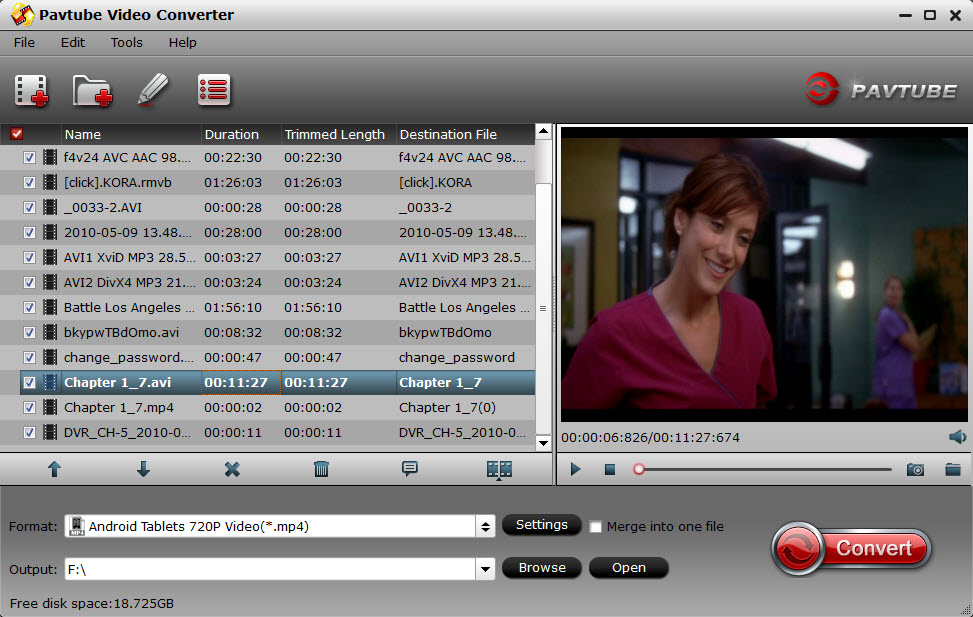 Step 2. Choose the output formatVisit the bottom of the application and then select WMV as the output format. All the videos converted at the same time will be converted in the same output format.
Step 2. Choose the output formatVisit the bottom of the application and then select WMV as the output format. All the videos converted at the same time will be converted in the same output format.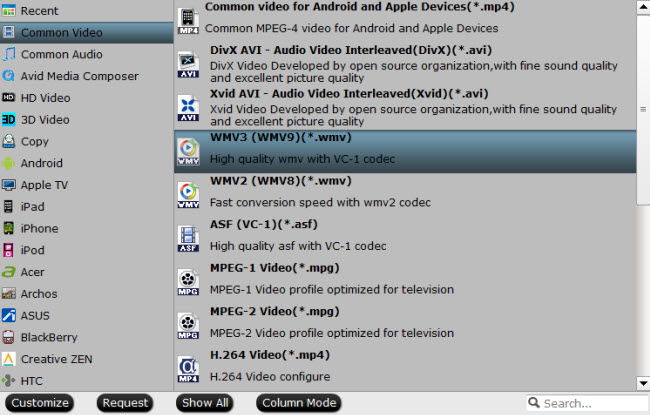 Step 3. Push convertYou just need to press the "Convert" button now. The video will be converted within seconds.Read More:
Step 3. Push convertYou just need to press the "Convert" button now. The video will be converted within seconds.Read More:
Summary: The article will give you the best solution to slove the issue of failing to import MP4 to iMovie to ddit MP4 in iMovie 11/10/09/08/HD.Why Sometimes Can't Import MP4 to iMovie?iMovie only supports importing MP4 formats with MPEG4/AAC or H.264/AAC data, not all kinds of MP4 formats. Some MP4 files from like Sony, Hybrid camcorders and other devices cannot be accepted by iMovie.iMovie contains all the essential codecs to read MP4 files. Any different codecs included in audio and subtitle will cause the issue. In the circumstances, we still cannot successfully import MP4 files to iMovie.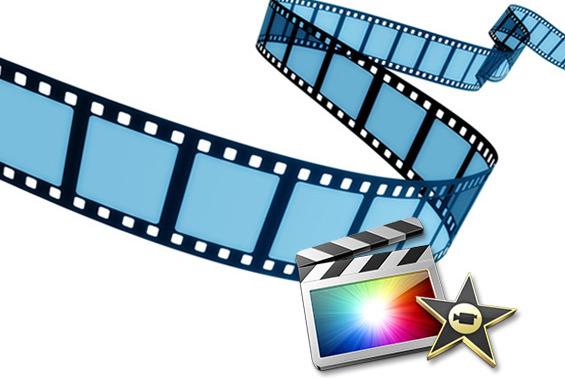 To smoothly import MP4 to iMovie, you'd better to convert these MP4 files to iMovie totally compatible MP4 or MOV (QuickTime) formats.Slove MP4 to iMovie issue(iMovie'11 Included)Here, I highly recommend Pavtube Video Converter for Mac -- MP4 to iMovie Converter for Mac to successfully convert MP4 to iMovie supported MP4 or MOV (QuickTime) formats. Hot Search: AVCHD MP4 to iMovie | 4K Video to iMovie/FCE/FCP | Exporting iMovie projects in different ways
To smoothly import MP4 to iMovie, you'd better to convert these MP4 files to iMovie totally compatible MP4 or MOV (QuickTime) formats.Slove MP4 to iMovie issue(iMovie'11 Included)Here, I highly recommend Pavtube Video Converter for Mac -- MP4 to iMovie Converter for Mac to successfully convert MP4 to iMovie supported MP4 or MOV (QuickTime) formats. Hot Search: AVCHD MP4 to iMovie | 4K Video to iMovie/FCE/FCP | Exporting iMovie projects in different ways
 Pavtube MP4 to iMovie Converter for Mac has the following features:
Pavtube MP4 to iMovie Converter for Mac has the following features:
- Works on 10.11(El Capitan), 10.10(Yosemite), 10.9(Mavericks), 10.8(Mountain Lion), 10.7(Lion), 10.6(Snow Leopard), or Mac OS X v10.5(Leopard);
- Except Converting MP4 to iMovie, Faasoft MP4 to iMovie Converter for Mac also supports nearly all kinds of video formats like MOV, AVI, WMV, MPEG, FLV, MKV, OGV, 3GP, MXF, WebM, AVCHD, MTS, M2T, M2TS, TOD, SWF, MVI, ASF, MOD, XAVC to iMovie;
- Acts as an inbuilt editor: trim, crop, merge files into one, split by chapter, rotate, adjust sound volume, add or remove subtitles, add effect/watermark to video files, adjust video/audio bitrate, codec, channels, frame rate, sample rate, resolution, aspect ratio and etc.
Step by Step Guide to Convert MP4 to iMovieStep 1 Add MP4 to Pavtube MP4 to iMovie Converter for MacLaunch the program on your Mac, add MP4 files to the program by clicking the "Add Video" or "Add folder" button, or just simply drag and drop MP4 that you want to convert to the main interface of program. Step 2 Set output formatFrom "Format" drop-down option, choose the output format according to your own preference, for iMovie editing, select "iMovie and Final Cut Ex..." > "Apple Intermediate Codec (AIC)(*.mov) to output.
Step 2 Set output formatFrom "Format" drop-down option, choose the output format according to your own preference, for iMovie editing, select "iMovie and Final Cut Ex..." > "Apple Intermediate Codec (AIC)(*.mov) to output.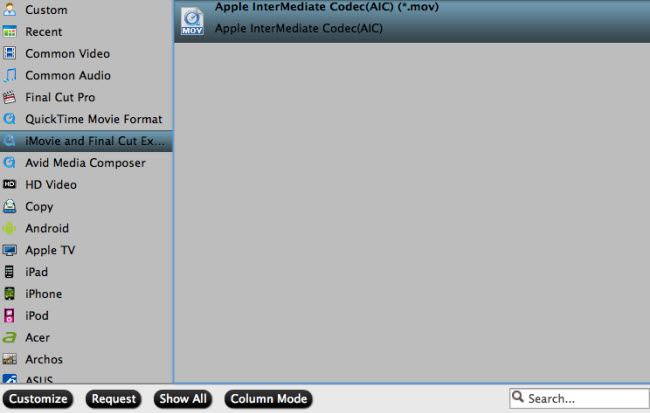 Step 3 Convert MP4 to iMovieClick the big "Convert" button of to start MP4 to iMovie conversion.When the conversion finished, click "Open Folder" to get the converted files. Then start your iMovie, and choose "File" > "Import" > "Movies". You can freely drag the converted MP4 files to iMovie.Read More:
Step 3 Convert MP4 to iMovieClick the big "Convert" button of to start MP4 to iMovie conversion.When the conversion finished, click "Open Folder" to get the converted files. Then start your iMovie, and choose "File" > "Import" > "Movies". You can freely drag the converted MP4 files to iMovie.Read More:
Summary: Feel the necessity to convert MP4 to MOV format? This tutorial shares a free video converter that helps you handle any MP4 to MOV conversion for free, so that you can enjoy videos on QuickTim easily.When it comes to a video format, MP4 may first come into your mind since this MPEG-4 Part 14 file format enables you to limitlessly access to almost all media players. However, even though such multimedia container is near-perfect, there still has something to improve.QuickTime is an extensible multimedia framework powered by Apple Inc., which has the feature of handling various formats of digital video, picture, sound, panoramic images, and interactivity. Since QuickTime is compatible with both Windows (Windows XP and later) and Mac (Mac OS X Leopard and later) and very powerful, it is quite popular. Although MP4's file structure is based on Apple’s QuickTime technology, its data embedded in this MPEG-4 Part 14 file, like MPEG-4 Part 10 (known as H.264/MPEG-4 AVC), MPEG-4 Part 2, etc, causes a codec problem which doesn't work well with Apple products. As a result, if you'd like to play MP4 on QuickTime, you’d better convert MP4 to MOV on Mac first because the MOV container is the default format of Mac OS X and performs optimum compatibility with QuickTime.To solve QuickTime won't play MP4 issue, a strongly recommended solution is to convert all kinds of MP4 videos and movies to QuickTime more compatible MOV formats.How to Convert Various Kinds of MP4 Files to QuickTime Formats?Works as a professional Video Converter, Pavtube Video Converter / Mac Version is your best choice, which can convert different kinds of MP4 videos and movies to QuickTime supported MOV, MP4 formats for playback, no matter the MP4 files are encoded with which kind of audio and video codecs. Besides, Pavtube Video Converter supports converting more than +160 video and audio formats. How powerful it is!Pavtube Video Converter is also an all-in-one video converter, editor and player, with which, you can convert files among hundreds of formats, optimize your video and movie as your liking and play almost all kinds of video and audio files freely. It is really get sth done once and forever.
Although MP4's file structure is based on Apple’s QuickTime technology, its data embedded in this MPEG-4 Part 14 file, like MPEG-4 Part 10 (known as H.264/MPEG-4 AVC), MPEG-4 Part 2, etc, causes a codec problem which doesn't work well with Apple products. As a result, if you'd like to play MP4 on QuickTime, you’d better convert MP4 to MOV on Mac first because the MOV container is the default format of Mac OS X and performs optimum compatibility with QuickTime.To solve QuickTime won't play MP4 issue, a strongly recommended solution is to convert all kinds of MP4 videos and movies to QuickTime more compatible MOV formats.How to Convert Various Kinds of MP4 Files to QuickTime Formats?Works as a professional Video Converter, Pavtube Video Converter / Mac Version is your best choice, which can convert different kinds of MP4 videos and movies to QuickTime supported MOV, MP4 formats for playback, no matter the MP4 files are encoded with which kind of audio and video codecs. Besides, Pavtube Video Converter supports converting more than +160 video and audio formats. How powerful it is!Pavtube Video Converter is also an all-in-one video converter, editor and player, with which, you can convert files among hundreds of formats, optimize your video and movie as your liking and play almost all kinds of video and audio files freely. It is really get sth done once and forever.
 Other Download:- Pavtube old official address: http://www.pavtube.com/video_converter/- Amazon Download: http://download.cnet.com/Pavtube-Video-Converter/3000-2194_4-75734821.html- Cnet Download: http://download.cnet.com/Pavtube-Video-Converter/3000-2194_4-75734821.htmlSteps on How to Convert MP4 to QuickTime Supported FormatsFree download and install this powerful Pavtube Video Converter, and then follow the step by step guide to finish MP4 to QuickTime transformation.Step 1 Load MP4 to Pavtube Video ConverterSimply drag and drop MP4 files to MP4 to QuickTime Converter. To batch convert a couple of MP4 files, put them in one folder and then drag this MP4 folder to MP4 to QuickTime Converter, you'll see the files are loading in the task list in order quickly.
Other Download:- Pavtube old official address: http://www.pavtube.com/video_converter/- Amazon Download: http://download.cnet.com/Pavtube-Video-Converter/3000-2194_4-75734821.html- Cnet Download: http://download.cnet.com/Pavtube-Video-Converter/3000-2194_4-75734821.htmlSteps on How to Convert MP4 to QuickTime Supported FormatsFree download and install this powerful Pavtube Video Converter, and then follow the step by step guide to finish MP4 to QuickTime transformation.Step 1 Load MP4 to Pavtube Video ConverterSimply drag and drop MP4 files to MP4 to QuickTime Converter. To batch convert a couple of MP4 files, put them in one folder and then drag this MP4 folder to MP4 to QuickTime Converter, you'll see the files are loading in the task list in order quickly.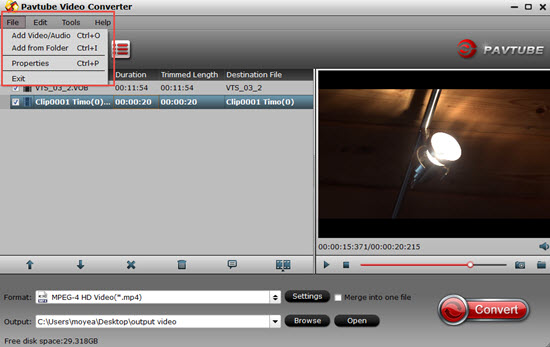 Step 2 Set QuickTime compatible formatsClick "Profile" drop-down button to choose "MOV QuickTime Video (*.mov)" as output video format from the "General Video" category.
Step 2 Set QuickTime compatible formatsClick "Profile" drop-down button to choose "MOV QuickTime Video (*.mov)" as output video format from the "General Video" category.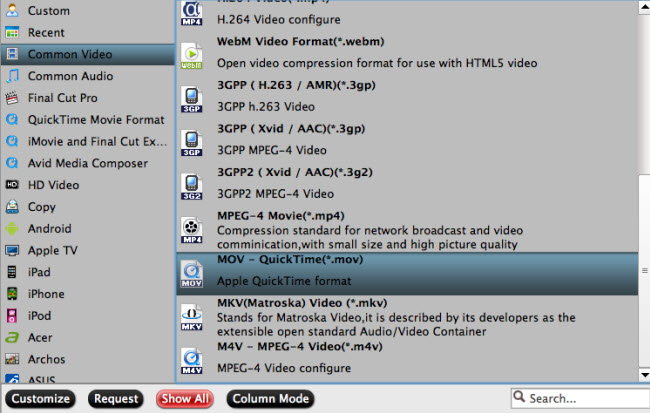 Step 3 Convert MP4 to QuickTimeClick the big "Convert" button to start converting MP4 to QuickTime with fast conversion speed.Related program:Pavtube HD Video Converter / Mac Version: It is designed for converting HD videos from HD camcorders or DVs (like JVC, Panasonic, Sony and Cannon), non-protected HD or movies, DVR files (*.tivo) to other file types for playback on popular media devices like Apple TV, PS3, Xobx, Xobx360, WD TV HD Player.Read More:
Step 3 Convert MP4 to QuickTimeClick the big "Convert" button to start converting MP4 to QuickTime with fast conversion speed.Related program:Pavtube HD Video Converter / Mac Version: It is designed for converting HD videos from HD camcorders or DVs (like JVC, Panasonic, Sony and Cannon), non-protected HD or movies, DVR files (*.tivo) to other file types for playback on popular media devices like Apple TV, PS3, Xobx, Xobx360, WD TV HD Player.Read More:
Full HDTV, also referred to as ultra-HD, true HDTV, and 1080p, is a television (TV) display technology that surpasses the video quality and sharpness of the original high-definition television (HDTV) technology, providing an image resolution of 1920 by 1080 pixels. The original HDTV technology offers vertical resolution that ranges from 720 lines with progressive scanning (720p) to 1080 lines with interlaced scanning (1080i). Full HDTV provides 1080 lines with progressive scanning (sometimes referred to as 1080p). In these specifications, the numeral indicates the number of horizontal lines in the complete raster, the p stands for progressive scanning (where each scan displays every line in the image raster sequentially from top to bottom), and the i stands for interlaced scanning (where each scan displays alternate lines in the image raster, and two complete scans are therefore required to display the entire image).Progressive scanning is considered superior to interlaced scanning for full-motion video displays, because there is less jitter, particularly for the portrayal of objects that move diagonally or vertically across the screen. The improvement is especially noticeable for fast-moving images, typical of television and DVD programs. Another advantage of progressive scanning is the fact that it is required for satisfactory video on TV sets that use micro displays, plasma displays, or liquid-crystal display (LCD) flat panels, all of which are becoming increasingly popular. The improved image quality afforded by full HDTV is well suited to the extra-large-screen displays used in home theater systems.The information you have got from above you still can’t decided which type TV should you buy? You still doubt with weather all the video can be played on the big screen HDTV? Here recommend you a professional tool, Pavtube HD Video Converter for Mac(review). with it, all kinds of video can be imported or transfer to the TV you will get. It enables you to convert any video to Ultra HD TV format. You can freely play video taken by camcorders, cameras, and mobile phones on all TVs.
The original HDTV technology offers vertical resolution that ranges from 720 lines with progressive scanning (720p) to 1080 lines with interlaced scanning (1080i). Full HDTV provides 1080 lines with progressive scanning (sometimes referred to as 1080p). In these specifications, the numeral indicates the number of horizontal lines in the complete raster, the p stands for progressive scanning (where each scan displays every line in the image raster sequentially from top to bottom), and the i stands for interlaced scanning (where each scan displays alternate lines in the image raster, and two complete scans are therefore required to display the entire image).Progressive scanning is considered superior to interlaced scanning for full-motion video displays, because there is less jitter, particularly for the portrayal of objects that move diagonally or vertically across the screen. The improvement is especially noticeable for fast-moving images, typical of television and DVD programs. Another advantage of progressive scanning is the fact that it is required for satisfactory video on TV sets that use micro displays, plasma displays, or liquid-crystal display (LCD) flat panels, all of which are becoming increasingly popular. The improved image quality afforded by full HDTV is well suited to the extra-large-screen displays used in home theater systems.The information you have got from above you still can’t decided which type TV should you buy? You still doubt with weather all the video can be played on the big screen HDTV? Here recommend you a professional tool, Pavtube HD Video Converter for Mac(review). with it, all kinds of video can be imported or transfer to the TV you will get. It enables you to convert any video to Ultra HD TV format. You can freely play video taken by camcorders, cameras, and mobile phones on all TVs.
 Other Download:
Steps of Convert Any video on TV on MacStep 1. Run Pavtube HD Video Converter for Mac. Click "Add Video" button, load them to the converter.
Other Download:
Steps of Convert Any video on TV on MacStep 1. Run Pavtube HD Video Converter for Mac. Click "Add Video" button, load them to the converter. 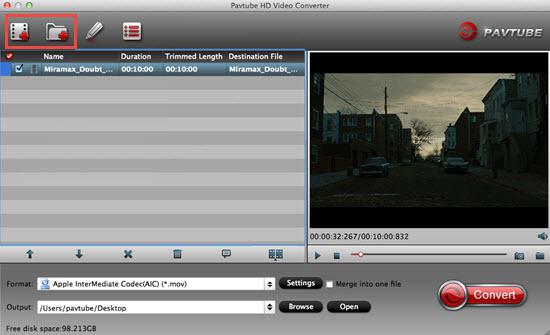 Step 2. Select the items to be converted, and click on "Format" bar.Here I would recommend you select H.265 format which can keep the high definition of the source video.
Step 2. Select the items to be converted, and click on "Format" bar.Here I would recommend you select H.265 format which can keep the high definition of the source video.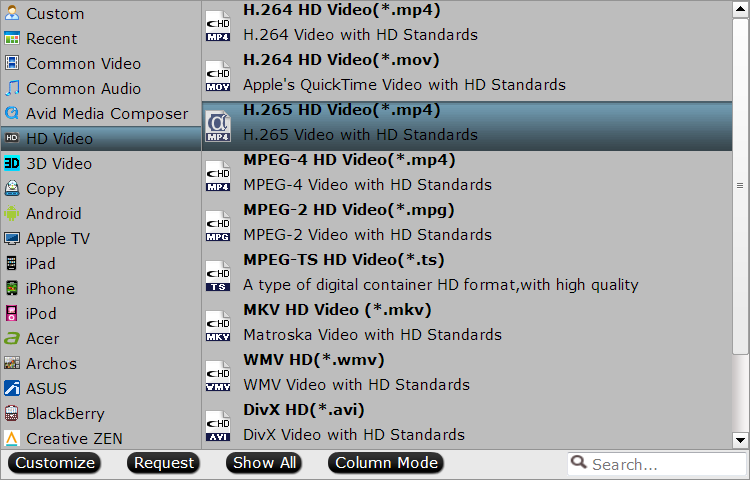 Step 3. Click "Settings" button, then you will be able to adjust audio and video parameters on the popup window to customize the output file quality, these adjustable parameters include codec name, aspect ratio, bit rate, frame rate, sample rate, and audio channel.Tips: To maintain original HD quality, you may set "original" in the fields of "Size", "Bitrate" and "Frame rate".Step 4. Click the "Convert" button to start converting any video into Ultra HD video. After conversion you can click the "Open" and transfer to TV for watching.Related program: Pavtube MXF Converter / Mac Version: can handle MXF/MXF footage produced by Canon, Sony and Panasonic camcorders and convert MXF video files to various video format supported by popular devices such as iPad Air/4/3, iPhone 5S/5C/5/4S/4, Apple TV 3, Google Nexus, Samsung Galaxy Tab S/3/2, Samsung Galaxy S5/S4/S3, Surface RT/Pro, PS4/PS3, WDTV, etc.Pavtube MTS/M2TS Converter / Mac Version:The best MTS converter on the market, which can convert MTS videos and other HD formats to FCP X Apple ProRes codec MOV format, or convert MTS to Avid Media Composer/Adobe Premiere Pro/iMovie native supported video format.Pavtube Media Magician / Mac Version: A nice camcorder assistant manager, lossless camcorder video joiner, MTS/ M2TS/ MXF/ MOV/ MKV/ TiVo/ WMV/ AVI/ MPG converter and editor. Meamwhile it supported upload edited video to YouTube directly.Read More:
Step 3. Click "Settings" button, then you will be able to adjust audio and video parameters on the popup window to customize the output file quality, these adjustable parameters include codec name, aspect ratio, bit rate, frame rate, sample rate, and audio channel.Tips: To maintain original HD quality, you may set "original" in the fields of "Size", "Bitrate" and "Frame rate".Step 4. Click the "Convert" button to start converting any video into Ultra HD video. After conversion you can click the "Open" and transfer to TV for watching.Related program: Pavtube MXF Converter / Mac Version: can handle MXF/MXF footage produced by Canon, Sony and Panasonic camcorders and convert MXF video files to various video format supported by popular devices such as iPad Air/4/3, iPhone 5S/5C/5/4S/4, Apple TV 3, Google Nexus, Samsung Galaxy Tab S/3/2, Samsung Galaxy S5/S4/S3, Surface RT/Pro, PS4/PS3, WDTV, etc.Pavtube MTS/M2TS Converter / Mac Version:The best MTS converter on the market, which can convert MTS videos and other HD formats to FCP X Apple ProRes codec MOV format, or convert MTS to Avid Media Composer/Adobe Premiere Pro/iMovie native supported video format.Pavtube Media Magician / Mac Version: A nice camcorder assistant manager, lossless camcorder video joiner, MTS/ M2TS/ MXF/ MOV/ MKV/ TiVo/ WMV/ AVI/ MPG converter and editor. Meamwhile it supported upload edited video to YouTube directly.Read More:
Summary: This article keep eyes on the solution to edit the parrot bebop drone video in Avid, if you just have the issue of import and edit this video in Avid, you have come to the right place. You’ve graduated from your cheap beginner drone, and you want to try something new. Something that can shoot beautiful video from the sky—but doesn’t cost $1,000+ like a camera-equipped DJI Phantom. You spend the $500 Parrot Bebop Drone, and pull the trigger. It’s kind of fun, you think, between strings of obscenities.Perhaps you have know some detail of the Parrot Bebop Drone. It can capture video at 1080p full-HD resolution; the AR.Drone 2.0 is limited to 720p. Video is recorded to the Bebop's 8GB of internal storage (there's no microSD or SD card slot) in MP4 format. The reason why you are failed to import or cannot edit parrot bebop drone video in Avid smoothly is that the mp4 format is not a friendly editing format but a container format. For Avid, the best compatible format is DNxHD, if you want to edit the Parrot Bebop Drone video in Avid smoothly, you just need to change the original video format into DNxHD.Hot Search: 4K Video to Avid | FCP ProRes to Avid MC DNxHD | Avid DNxHD MXF to FCP XPavtube Video Converter for Mac(read the review) are highly recommended here, which helps to output Avid native editable DNxHD codec from Parrot Bebop Drone for further professional editing on Mac.By the way, if your are a one hundred percent Windows user, please turn to Pavtube Video Converter. It has the same ability as Mac version. 
 Other Download:- Pavtube old official address: http://www.pavtube.com/video-converter-mac/- Amazon Store Download: http://www.amazon.com/Pavtube-Video-Converter-Mac-Download/dp/B00QIBK0TQ- Cnet Download: http://download.cnet.com/Pavtube-Video-Converter/3000-2194_4-76179460.htmlStep by step to convert Parrot Bebop Drone to Avid Media Composer DNxHD on MacStep 1: Add Parrot Bebop Drone files to the program.Click "Add Video" button or "Add from folder" button to import the Parrot Bebop Drone files to the application.
Other Download:- Pavtube old official address: http://www.pavtube.com/video-converter-mac/- Amazon Store Download: http://www.amazon.com/Pavtube-Video-Converter-Mac-Download/dp/B00QIBK0TQ- Cnet Download: http://download.cnet.com/Pavtube-Video-Converter/3000-2194_4-76179460.htmlStep by step to convert Parrot Bebop Drone to Avid Media Composer DNxHD on MacStep 1: Add Parrot Bebop Drone files to the program.Click "Add Video" button or "Add from folder" button to import the Parrot Bebop Drone files to the application. Tips: Before inputting files to the program, you will first need to transfer the Parrot Bebop Drone files to your local hard drive. You can connect the camera with the memory card inside to your computer via a USB cable, then turn your memory card on to locate and transfer the files to your computer hard drive.Step 2: Select Avid DNxHD as output file format.From the "Format" bar drop-down list, select "Avid Media Composer">"Avid DNxHD(*mov)" as the desired format for editing in Avid Media Composer.
Tips: Before inputting files to the program, you will first need to transfer the Parrot Bebop Drone files to your local hard drive. You can connect the camera with the memory card inside to your computer via a USB cable, then turn your memory card on to locate and transfer the files to your computer hard drive.Step 2: Select Avid DNxHD as output file format.From the "Format" bar drop-down list, select "Avid Media Composer">"Avid DNxHD(*mov)" as the desired format for editing in Avid Media Composer. Step 3: Customize output profile parameters.Hit "Settings" on the main interface to open "Profile Settings" window, here you can adjust otuput video codec, size, frame rate, bit rate and audio codec, sample rate, bit rate and channels according to your own preference and needs.
Step 3: Customize output profile parameters.Hit "Settings" on the main interface to open "Profile Settings" window, here you can adjust otuput video codec, size, frame rate, bit rate and audio codec, sample rate, bit rate and channels according to your own preference and needs.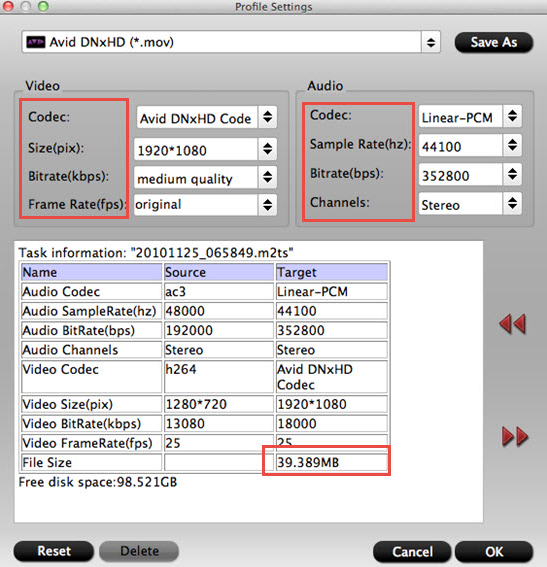 Step 4: Transcode Parrot Bebop Drone files to Avid DNxHD.When all the setting is completed, hit the right-bottom convert button to start Parrot Bebop Drone files to Avid Media Composer DNxHD conversion.When the conversion completes, find the output folder with converted files by clicking the "Open" icon on the main interface, then feel free to do the post work-flows with Avid Media Composer.Read More:
Step 4: Transcode Parrot Bebop Drone files to Avid DNxHD.When all the setting is completed, hit the right-bottom convert button to start Parrot Bebop Drone files to Avid Media Composer DNxHD conversion.When the conversion completes, find the output folder with converted files by clicking the "Open" icon on the main interface, then feel free to do the post work-flows with Avid Media Composer.Read More:
Summary: In this article I will show the main different between fcp 7 and fcp x, and share you how to import and edit the video into fcp x for smoothly editing. Here we go.The main one you'll see is the way in which the Timeline is constructed and utilized. There are no longer "tracks" to edit on, such as A1 & A2, V1, etc. All clips go into what's called a "Primary Storyline", and secondary footage (b-roll) "connects" to those clips. This allows for connected clips to always move together, keeping you from going out of sync. The "magnetic timeline", as it's called also has the great feature of clips moving out of the way and onto another level when other clips are brought in contact with them. It saves steps and organizes clips together better.The other key feature I can point out here is the ability to organize clips in the Browser. You can choose favorite clips, mark pieces of clips with Keywords, mark sections of clips as unusable and a whole lot more. Then you can view clips in your Browser by selecting the categories you've created. In other words, any clip you gave a specific Keyword to can be pulled up instantly.The biggest difference is that FCP 7 uses the old video-and-audio-tracks interface, where the picture and sound signals have their own track in the timeline. FCP X combines them all into one "track" called a Storyline, though you can separate the audio tracks if you need to.In FCP 7 if you wanted to move a clip around along with any other clips sitting on top of it, you had to select them all and move them manually or use copy and paste. In FCP X, when you move a clip, any attached b-roll clips automatically move along with the primary one. This is incredibly helpful when you want to rearrange entire scenes. There has been no official word from Apple regarding an upcoming version of FCP, but there are many changes that pro users are wanting/anticipating:
- 64 bit
- Better Color and Motion Integration
- Native DSLR (H.264) and P2 compatibility
- Fix gamma issues between applications
- Better text tools
- Native 3D integration
- Better tracking tools
- Better stability for large project files
- Integration with After Effects (not likely)
- Scratch folders linked to project folders (smart updating)
- Optical flow slow motion
- Easier way to work with keyframes?
- Media manage elements across Pro Apps
- Better audio controls and filters (the current filter audio interface is archaic)
- Save scripts for presets, motion & effects
- Update Color's UI
I could write all day about other differences, but the ability to organize clips and then utilize them in an advanced Timeline are two big differences. Maybe in a future post I'll address more. In the next i would like to show you how to import and edit the video into fcp x for smoothly editing.As we all know that like other professional non-linear video editing program, Final Cut Pro also has its own native editing codec - Apple ProRes, which is specially designed for nonlinear editing and complex multi-generation composing in post production. To create Final Cut Pro Apple ProRes editing codec, you can download Pavtube Video Converter for Mac(read the review), a professional Mac video decoder to beneficially encode all kinds of your recorded video to Final Cut Pro X(7) optimized Apple ProRes codec.Hot Search: H.265/HEVC to FCP X | DJI Phantom 3 4K Video with FCP X | 4K MXF to FCP XBy the way, if your are a one hundred percent Windows user, please turn to Pavtube Video Converter. It has the same ability as Mac version. 
 Other Download:- Pavtube old official address: http://www.pavtube.com/video-converter-mac/- Amazon Store Download: http://www.amazon.com/Pavtube-Video-Converter-Mac-Download/dp/B00QIBK0TQ- Cnet Download: http://download.cnet.com/Pavtube-Video-Converter/3000-2194_4-76179460.htmlSteps for Import and Edit with FCP X(7) SmoothlyStep 1: Add camcorder video files to the program.Launch the software on your Mac computer, click "File" menu, select "Add Video/Audio" or "Add from folder" to import video to the program.
Other Download:- Pavtube old official address: http://www.pavtube.com/video-converter-mac/- Amazon Store Download: http://www.amazon.com/Pavtube-Video-Converter-Mac-Download/dp/B00QIBK0TQ- Cnet Download: http://download.cnet.com/Pavtube-Video-Converter/3000-2194_4-76179460.htmlSteps for Import and Edit with FCP X(7) SmoothlyStep 1: Add camcorder video files to the program.Launch the software on your Mac computer, click "File" menu, select "Add Video/Audio" or "Add from folder" to import video to the program. Step 2: Choose output format.Click "Format" bar, from its drop-down options, move your mouse to "Final Cut Pro > Apple ProRes 422 (*.mov)" to select it as the output file format.
Step 2: Choose output format.Click "Format" bar, from its drop-down options, move your mouse to "Final Cut Pro > Apple ProRes 422 (*.mov)" to select it as the output file format. Step 3: Customize output ProRes parameters.Open "Profile Settings" window to adjust the output video codec, size, bit rate, frame rate, audio codec, sample rate, bit rate and channels.
Step 3: Customize output ProRes parameters.Open "Profile Settings" window to adjust the output video codec, size, bit rate, frame rate, audio codec, sample rate, bit rate and channels. Step 4: Convert to Apple ProRes for FCP X.Hit the convert button under the preview windows, the program will start Apple ProRes MOV conversion for Final Cut Pro X(7).When the conversion is completed, run FCP(7) and import the ProRes codec footage for post production workflow.Read More:
Step 4: Convert to Apple ProRes for FCP X.Hit the convert button under the preview windows, the program will start Apple ProRes MOV conversion for Final Cut Pro X(7).When the conversion is completed, run FCP(7) and import the ProRes codec footage for post production workflow.Read More:
Summary: Trouble editing or playing video in Avid Media Composer with Youtube MP4 footage because of compatibility issues? Your troubles are over.As a quite hot file extension, MP4 is widely used for saving media data and can be found in lots of places online or off line, which means, you can get MP4 videos from YouTube, or shared MP4 videos from others. However, you may run into a situation where you can't edit MP4 files in Avid Media Composer. The Media Composer deals with the MP4 files at quite a slow speed and some MP4 files even cannot be recognized. So what's matter? What is the available way to use MP4 files in Avid Media Composer?Actually, this is probably due to the MP4 file codec. Avid might not work with some MP4 files sometimes due to the codec issue or other reasons. Fortunately, there is an easy way to fix the issue. To get Avid Media Composer work well with MP4 videos, you could adjust MP4 to Avid MC supported video format. Hot Search: QuickTime Files to Avid | H.265 to Avid | XAVC S to AvidAlong with some help from third-party software like Pavtube Video Converter for Mac (Yosemite, Mavericks, Mountain Lion, Lion included), you can easily get the problem solved. With it, you can transcode MP4 to Avid native editing-friendly format - DNxHD - ensuring maximum editing quality and efficiency when working with Avid Media Composer. An Avid preset is included for easy access. If you are running a Windows PC, get Pavtube Video Converter.
 Other Download:- Pavtube old official address: http://www.pavtube.com/video-converter-mac/- Amazon Store Download: http://www.amazon.com/Pavtube-Video-Converter-Mac-Download/dp/B00QIBK0TQ- Cnet Download: http://download.cnet.com/Pavtube-Video-Converter/3000-2194_4-76179460.htmlNow download the program and follow the step-by-step gudie below to convert MP4 files to Avid DNxHD for smoothly editing.Step 1. Import YouTube MP4 files into the programHere you can directly drag & drop the YouTube MP4 files to the converter, or click "Add Video" button to load your video files.
Other Download:- Pavtube old official address: http://www.pavtube.com/video-converter-mac/- Amazon Store Download: http://www.amazon.com/Pavtube-Video-Converter-Mac-Download/dp/B00QIBK0TQ- Cnet Download: http://download.cnet.com/Pavtube-Video-Converter/3000-2194_4-76179460.htmlNow download the program and follow the step-by-step gudie below to convert MP4 files to Avid DNxHD for smoothly editing.Step 1. Import YouTube MP4 files into the programHere you can directly drag & drop the YouTube MP4 files to the converter, or click "Add Video" button to load your video files. Step 2. Choose DNxHD as the output formatYou can directly choose the DNxHD preset from "Editing Software" category for Avid Media Composer which has been supplied by the MP4 to Avid Mac Converter. The settings also works for Avid MC 8, Avid MC 7, Avid MC 6 and Avid MC 5 etc.
Step 2. Choose DNxHD as the output formatYou can directly choose the DNxHD preset from "Editing Software" category for Avid Media Composer which has been supplied by the MP4 to Avid Mac Converter. The settings also works for Avid MC 8, Avid MC 7, Avid MC 6 and Avid MC 5 etc. Step 3. Start YouTube MP4 to Avid DNxHD conversion on Mac.When everything is ready, click the Convert button and all the imported YouTube MP4 video files will be converted to DNxHD MOV files.After the conversion, simply click the "Open" button to find the converted videos. Now you can ingest the converted YouTube MP4 files to Avid Media Composer for editing smoothly.Read More:
Step 3. Start YouTube MP4 to Avid DNxHD conversion on Mac.When everything is ready, click the Convert button and all the imported YouTube MP4 video files will be converted to DNxHD MOV files.After the conversion, simply click the "Open" button to find the converted videos. Now you can ingest the converted YouTube MP4 files to Avid Media Composer for editing smoothly.Read More:





















